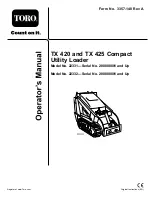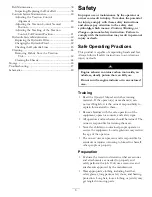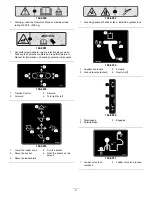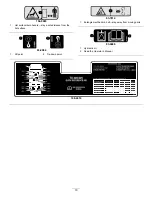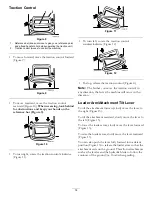
•
Inspect the area where the equipment is to be used
and remove all objects such as rocks, toys, and wire
which can be thrown by the machine.
•
Use extra care when handling gasoline and other
fuels. They are flammable and vapors are explosive.
– Use only an approved container
– Never remove the gas cap or add fuel with the
engine running. Allow the engine to cool before
refueling. Do not smoke.
– Never refuel or drain the machine indoors.
•
Check that the operator’s presence controls, safety
switches, and shields are attached and functioning
properly. Do not operate unless they are functioning
properly.
Operation
•
Never run an engine in an enclosed area.
•
Only operate in good light, keeping away from holes
and hidden hazards.
•
Be sure all drives are in neutral and parking brake is
engaged before starting the engine. Only start the
engine from the operator’s position.
•
Slow down and use extra care on hillsides. Be sure
to travel in the recommended direction on hillsides.
Turf conditions can affect the machine’s stability.
•
Slow down and use caution when making turns and
when changing directions on slopes.
•
Never operate with the guards not securely in place.
Be sure all interlocks are attached, adjusted properly,
and functioning property.
•
Do not change the engine governor setting or
overspeed the engine.
•
Stop on level ground, lower implements, disengage
the auxiliary hydraulics, engage parking brake, shut
off the engine before leaving the operator’s position
for any reason.
•
Keep hands and feet away from moving attachments.
•
Look behind and down before backing up to be sure
of a clear path.
•
Never carry passengers and keep pets and bystanders
away.
•
Slow down and use caution when making turns and
crossing roads and sidewalks.
•
Do not operate the machine under the influence of
alcohol or drugs.
•
Use care when loading or unloading the machine
into a trailer or truck.
•
Use care when approaching blind corners, shrubs,
trees, or other objects that may obscure vision.
•
Read all attachment manuals.
•
Ensure that the area is clear of other people before
operating the traction unit. Stop the traction unit
if anyone enters the area.
•
Never leave a running traction unit unattended.
Always lower the loader arms, stop the engine, set
the parking brake, and remove the key before leaving.
•
Do not exceed the rated operating capacity, as the
traction unit may become unstable which may result
in loss of control.
•
Do not carry a load with the arms raised. Always
carry loads close to the ground.
•
Do not overload the attachment and always keep
the load level when raising the loader arms. Logs,
boards, and other items could roll down the loader
arms, injuring you.
•
Never jerk the controls; use a steady motion.
•
Watch for traffic when operating near or crossing
roadways.
•
Do not touch parts which may be hot from
operation. Allow them to cool before attempting to
maintain, adjust, or service.
•
Check for overhead clearances (i.e. branches,
doorways, electrical wires) before driving under any
objects and do not contact them.
•
Ensure that you operate the traction unit in areas
where there are no obstacles in close proximity to the
operator. Failure to maintain adequate distance from
trees, walls, and other barriers may result in injury
as the traction unit backs up during operation if the
operator is not attentive to the surroundings. Only
operate the unit in areas where there is sufficient
clearance for the operator to safely maneuver the
product.
•
Before digging, have the area marked for
underground utilities, and do not dig in marked areas.
•
Locate the pinch point areas marked on the traction
unit and attachments and keep hands and feet away
from these areas.
•
Before operating the traction unit with an
attachment, ensure that the attachment is properly
installed.
Slope Operation
Slopes are a major factor related to loss-of-control and
tip-over accidents, which can result in severe injury or
death. All slopes require extra caution.
•
Do not operate the traction unit on hillsides or
slopes exceeding the angles recommended in the
Stability Data section in Specifications , page 17, and
4
Содержание 22331 TX 420
Страница 7: ...Slope Chart 7 ...
Страница 48: ...Schematics Electrical Schematic Rev A 48 ...
Страница 49: ...Hydraulic Schematic Rev A 49 ...
Страница 50: ...Notes 50 ...
Страница 51: ...Notes 51 ...

